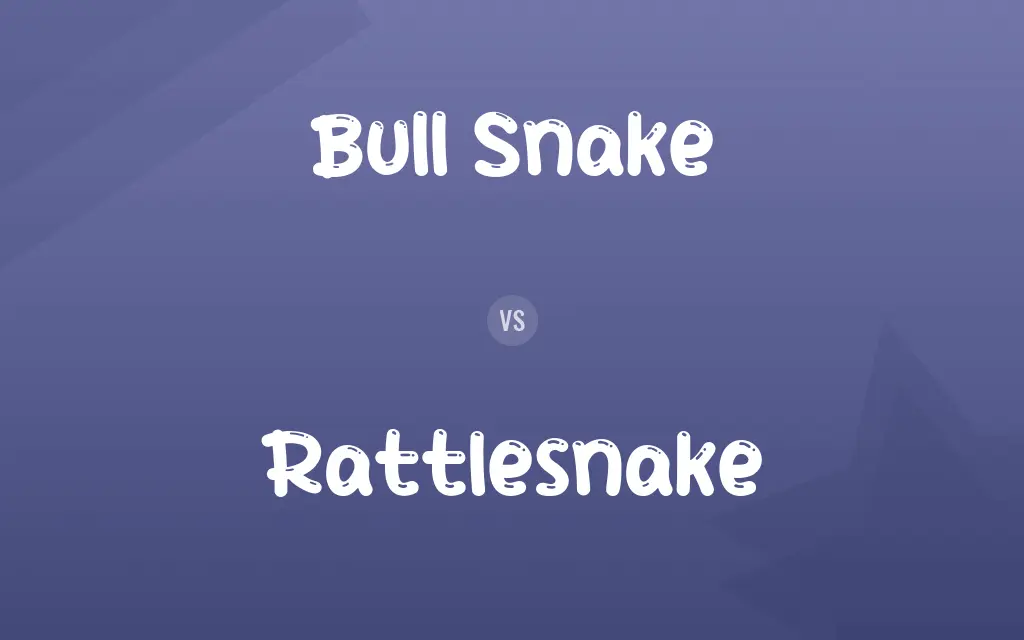Bull Snake vs. Rattlesnake: Difference and Comparison
Edited by Muazma Batool — By Muneeza Rehman — Published on April 5, 2024
Bull snakes are large, non-venomous constrictors found in North America, known for their aggressive defense behaviors. Rattlesnakes, venomous and equipped with a distinctive rattle at the end of their tails, are notorious for their potent bite.

Difference Between Bull Snake and Rattlesnake
Bull snakes (Pituophis catenifer) thrive in a variety of habitats, including forests, grasslands, and agricultural areas, where they play a crucial role in controlling rodent populations. Their ability to hiss loudly and vibrate their tails against dry leaves often leads to confusion with rattlesnakes. Rattlesnakes (Crotalus spp.), however, are primarily found in deserts, grasslands, and rocky areas, where their rattle serves as a warning to potential threats. This adaptation is unique among venomous snakes and aids in avoiding unnecessary confrontations.
Muneeza Rehman
Apr 05, 2024
The diet of bull snakes mainly consists of rodents, birds, and eggs, which they overpower through constriction before swallowing whole. Rattlesnakes, on the other hand, use their venom to immobilize or kill prey before consumption, which includes small mammals, birds, and occasionally reptiles. The venom also plays a critical role in self-defense against larger predators.
Muneeza Rehman
Apr 05, 2024
Physically, bull snakes are among the largest snakes in North America, reaching lengths of up to 8 feet (2.4 meters), with a robust build and distinct pattern of large, dark blotches on a yellowish background. Rattlesnakes vary in size and appearance but are generally smaller, with distinctive patterns that serve as camouflage and the unmistakable rattle.
Muneeza Rehman
Apr 05, 2024
Conservation statuses differ between species, with most bull snakes considered of least concern, thanks to their adaptability and broad range. Rattlesnakes face more significant threats from habitat loss, persecution, and illegal trade, leading to some species being listed as threatened or endangered.
Jonathan
Apr 05, 2024
Despite their differences, both bull snakes and rattlesnakes share the challenge of navigating environments increasingly impacted by human activity. Conservation efforts for rattlesnakes focus on habitat preservation and education to reduce unwarranted killing, while bull snakes benefit from their role in controlling pests in agricultural areas.
Nolan
Apr 05, 2024
Bull Snake vs. Rattlesnake Comparison Chart
Habitat
Forests, grasslands, agricultural areas
Deserts, grasslands, rocky areas
Muneeza Rehman
Apr 05, 2024
Diet
Rodents, birds, eggs (constriction)
Small mammals, birds (venomous bite)
Muneeza Rehman
Apr 05, 2024
Distinct Features
Large, dark blotches on a yellowish background
Distinctive patterns, rattle
Henry
Apr 05, 2024
Bull Snake vs. Rattlesnake Definitions
◉Bull Snake
A large, non-venomous constrictor native to North America.
The bull snake can often be found sunning itself in open fields.
Muneeza Rehman
Feb 21, 2024
◉Rattlesnake
Uses venom to immobilize prey.
The rattlesnake struck its prey with precision, delivering a lethal dose of venom.
Muneeza Rehman
Feb 21, 2024
◉Bull Snake
Known for mimicking rattlesnakes.
When threatened, the bull snake hisses and vibrates its tail.
Muneeza Rehman
Feb 21, 2024
◉Rattlesnake
Faces threats from habitat loss and persecution.
Conservation efforts are underway to protect rattlesnake habitats.
Muneeza Rehman
Feb 21, 2024
◉Bull Snake
Effective rodent predator.
Farmers appreciate the bull snake for its ability to control rodent populations.
Jonathan
Feb 21, 2024
◉Rattlesnake
A venomous snake with a distinctive rattle.
The rattlesnake's warning rattle can send chills down your spine.
Muneeza Rehman
Feb 21, 2024
◉Bull Snake
Among the largest North American snakes.
The bull snake we encountered was nearly 8 feet long.
William
Feb 21, 2024
◉Rattlesnake
Varied in size and coloration.
The diamondback rattlesnake is one of the largest and most recognizable species.
Nolan
Feb 21, 2024
◉Bull Snake
Adaptable to various habitats.
Bull snakes are as comfortable in a desert as they are in a grassland.
Elijah
Feb 21, 2024
◉Rattlesnake
Native to the Americas.
Rattlesnakes are found across a wide range of habitats in North and South America.
Jonathan
Feb 21, 2024
◉Bull Snake
Any of several large harmless rodent-eating North American burrowing snakes
Muneeza Rehman
Feb 20, 2024
◉Rattlesnake
Any of various venomous pit vipers of the genera Crotalus and Sistrurus of the Americas, having at the end of the tail a series of loosely attached, horny segments that can be vibrated to produce a rattling or buzzing sound.
Muneeza Rehman
Feb 20, 2024
Bull Snake vs. Rattlesnake Frequently Asked Questions
Can bull snakes and rattlesnakes hybridize?
There is no evidence to suggest that bull snakes and rattlesnakes can hybridize, as they belong to different families and have distinct reproductive behaviors.
Muneeza Rehman
Apr 05, 2024
How do rattlesnakes contribute to their ecosystems?
Rattlesnakes play a crucial role in controlling rodent populations, which helps prevent the spread of diseases and maintain ecological balance.
Olivia
Apr 05, 2024
What should you do if you hear a rattlesnake rattle?
If you hear a rattlesnake rattle, stop moving, locate the snake without approaching, and slowly back away to give it space.
Levi
Apr 05, 2024
Are bull snakes dangerous to humans?
Bull snakes are not dangerous to humans and are non-venomous, though their mimicry of rattlesnakes can cause alarm.
Muneeza Rehman
Apr 05, 2024
Can rattlesnake venom be fatal to humans?
Rattlesnake bites can be fatal without prompt medical treatment, but antivenom is highly effective if administered in time.
Muneeza Rehman
Apr 05, 2024
How can you tell a bull snake from a rattlesnake?
Besides the lack of a rattle, bull snakes have rounder heads, more uniform scales, and lack the heat-sensing pits found on rattlesnakes.
Muneeza Rehman
Apr 05, 2024
What are the conservation concerns for rattlesnakes?
Rattlesnakes face habitat destruction, direct persecution, and the illegal pet trade, which threaten their populations and necessitate conservation actions.
Leo
Apr 05, 2024
How do bull snakes hunt their prey?
Bull snakes use constriction to subdue their prey, wrapping their bodies around the animal to suffocate it before consumption.
Nolan
Apr 05, 2024
What is being done to protect rattlesnakes?
Conservation efforts include habitat protection, research, public education to reduce fear and hostility, and laws against killing or capturing them.
Jonathan
Apr 05, 2024
Why are bull snakes beneficial to farmers?
Bull snakes help control rodent populations, protecting crops and reducing the need for chemical rodenticides, which can be harmful to the environment.
Nolan
Apr 05, 2024
Content Creators
Written by
Muneeza RehmanAt Comparisons.wiki, Muneeza skillfully navigates the vast sea of information, ensuring clarity and accuracy as the lead content editor. With a keen eye for detail, she curates every comparison to enlighten and engage readers.
Edited by
Muazma BatoolAs a content editor, Muazma Batool is not just a grammar guru but a creative mastermind who breathes life into every word. With an eagle eye for detail and a passion for storytelling, she transforms bland text into engaging content that captivates audiences and drives results.

































